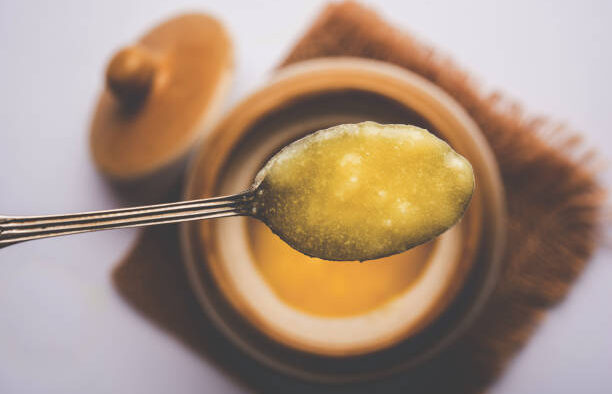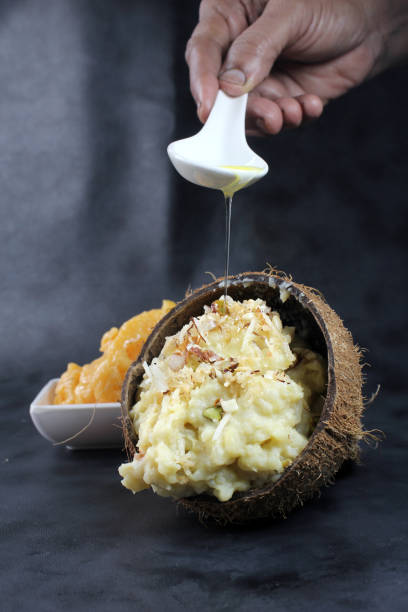Ayurveda has consistently for thousands of years promoted the use of gau ghrita (cow ghee) according to individual needs and their ability to digest it for a variety of reasons
The concept of fat and oil is widely misunderstood in today's society. While sneha includes all substances that are fatty or oily, it is a common misconception that they are simply heavy and harmful to the body. Our bodies have specific requirements for fats and oils to grow and flourish smoothly.
Scientific concepts of anatomy and physiology confirm that our 100 trillion human cells in each body depend on a lipid (fat) double-layer that protects the cell and its functions. The evidence for the importance of this bilayer is clearly seen in diseases where it is damaged or worn away. The insulation of brain cells by glial cells depends on the fatty insulation material provided. Brown fat is the good fat in our body that helps us preserve body temperature, especially in cold weather. Despite abundant medical knowledge about the importance of fat in our body and the need to consume fats in order to save the liver from having to divert from its other functions, there is still a misperception that eating fats and oils are unhealthy.
The categorical disdain for such an essential nutrient -- mostly due to advertising and commercial agendas -- has resulted in society excluding this most basic nutrient from our diet. Sneha includes not only the anatomic fat covering the vital organs but also the lubrication of our life force, the essence of our living. It is commonly defined as having oiliness, unctuousness, fattiness, greasiness, lubricity, and viscidity. But the Sanskrit language provides profound connections and deeper wisdom for human life.
Sneha also connotes smoothness, glossiness, tenderness, affection, or kindness, as discussed in Ayurveda in relation to the body. Unlike refined oils and fats, it nourishes all four levels of our continuum of Being: body, senses, mind, and soul. Sneha is also one of the 24 guṇa-s of the vaiśeṣika philosophy, a branch of nyāya- and the study of logic.
Ayurveda reminds us that all body constitutions require sneha for lubrication and stability. An individual's Prakriti is formed at the time of development of the fetus and remains constant from birth to death, but during the lifetime, different functions, seasons, and illnesses can cause changes in the amount and the way fats and oils are used by the body. Thus, Sneha must be one of the essential in a nutritious diet. The quantity and type vary according to the environment, but the fad for the past 50 years of full exclusion of essential fats results in depletion and deleterious effects on human physiology.
Knowing this, Ayurveda detailed knowledge about sneha and distinguished four varieties, ghrita (ghee), taila (oil), vasa(fat), and majja (bone marrow), the best of which is Ghrita. Ghee, or the Sanskrit term ghrita, is clarified cow butter made from cultured yogurt derived from pure cow milk. Gaughrita is the technical complete term.

When an eater sees ghee on the plate nowadays, he quickly avoids it in the name of excess oil, fat increasing, and heavy food. For a half-century, we have been reminded by modern sciences that foods high in saturated fat, such as ghee, are blamed for cardiovascular diseases, diabetes, stroke, and metabolic disorders. Only recently has the positive role of fats in the diet been explored by scientists.
In contrast, Ayurveda has consistently for thousands of years promoted the use of gau ghrita according to individual needs and their ability to digest it for a variety of reasons.
The Ghrita
Ghrita is one of India's most popular traditional dairy products. It has been used for religious rites, cooking, cosmetic, and medicinal purposes since the Vedic era tens of thousands of years ago, and it can be used both externally as lepa (poultice/skin cream) or tarpana (moisturizer/rehydrator) and internally as medicinal food or small-dosed drink.
When made properly from pasture-raised, whole and happy, mother cow milk to curd to butter to ghee, ghee has a unique property of effectively assimilating the properties of any ingredients added to it without losing its own inherent properties of cooling and oleating. Ayurveda also describes eight different types of medicinal ghrita made from the milk of eight different animals. Of them, ghrita made from cow's milk is known as gau ghrita and is regarded as the best.
Making Ghee
Many research studies show that the exact composition of ghrita varies, depending on the method of preparation. Commercially produced ghrita contains more saturated fatty acids than traditionally-produced ghrita. The indigenous traditional method has two sub-types.

In the first traditional method, cow milk is freshly harvested, soft-boiled on low heat, and then cooled. A teaspoon of yogurt (curd) is added and mixed well into the slightly warm milk and set to curdle in a warm setting. Once solidified fully, it is then churned to extract the butter, which floats to the top, leaving a yellow-green translucent liquid known as buttermilk. Ghee is made by heating the extracted butter.
In the second traditional method, cow milk is again freshly harvested, soft-boiled on low heat, and then cooled. When the cream hardens and floats on the top, it is removed carefully, collected and churned to extract the fat immediately. One day before making ghee, the extracted fat is then fermented with a tablespoon of curd. The fermented butter is heated the next day to make ghee.
Commercial methods simply collect the cream from milk using chemical processes, heat it to extract fat, add tomato seeds to give a yellow color, and prepare ghee from the clarified portion.
The fermentation process in the first traditional method seeks to prepare medicinal ghee, fermenting the milk to curd first, then churning to prepare fresh butter and then ghee. The second method is a time-saving recipe for food-grade, non-medicinal ghee, collecting the milk cream over several days then fermenting just a day prior to making ghee.
Ghee made through the fermentation process has a lower kapha and thus avoids prameha, urinary disorders that precede diabetes mellitus. As a result, traditional ghee contributes less to pathologic cholesterol production and is easier and lighter to digest. Butter, especially old butter that has later been clarified, is more difficult to digest.







